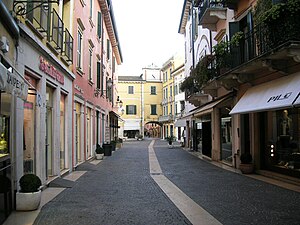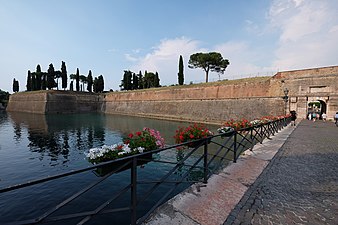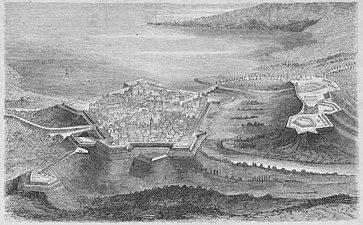Peschiera del Garda
Peschiera del Garda
Pischera (Venetian) | |
|---|---|
| Comune di Peschiera del Garda | |
 Monumental gate Verona | |
show Location of Peschiera del Garda | |
 Peschiera del Garda Location of Peschiera del Garda in Italy | |
| Coordinates: 45°26′N 10°41′E / 45.433°N 10.683°ECoordinates: 45°26′N 10°41′E / 45.433°N 10.683°E | |
| Country | Italy |
| Region | Veneto |
| Province | Verona (VR) |
| Frazioni | Broglie, San Benedetto di Lugana, Zanina |
| Government | |
| • Mayor | Gaiulli Orietta Maria |
| Area | |
| • Total | 17.63 km2 (6.81 sq mi) |
| Elevation | 68 m (223 ft) |
| Population (31 December 2020)[3] | |
| • Total | 10,856 |
| • Density | 620/km2 (1,600/sq mi) |
| Demonym(s) | Arilicensi |
| Time zone | UTC+1 (CET) |
| • Summer (DST) | UTC+2 (CEST) |
| Postal code | 37019, 37010 |
| Dialing code | 045 |
| Patron saint | Saint Martin |
| Saint day | November 11 |
| Website | Official website |
Peschiera del Garda (Italian pronunciation: [peˈskjɛːra del ˈɡarda]; Venetian: Pischera; Latin: Ardelica, Arilica) is a town and comune in the province of Verona, in Veneto, Italy. When Lombardy-Venetia was under Austrian rule, Peschiera was the northwest anchor of the four fortified towns constituting the Quadrilatero. The fortress is on an island in the river Mincio at its outlet from Lake Garda.
The town is encircled by massive Venetian defensive systems that have been a UNESCO World Heritage Site since 9 July 2017.[4]
| Fortified Town of Peschiera | |
|---|---|
| Location | Peschiera, Province of Verona, Veneto, Italy |
| Type | Cultural |
| Criteria | iii, iv |
| Designated | 2017 (41 Session) |
| Part of | Venetian Works of Defence between 15th and 17th centuries: Stato da Terra – western Stato da Mar |
| Reference no. | 1533 |
| Region | Europe and North America |
History[]
Roman Ardelica was a town of Gallia Transpadana that occupied the site of the modern Peschiera del Garda, at the southeast angle of the Lacus Benacus (Lago di Garda), just where the Mincius (modern Mincio) issued from the lake. The name is found under the corrupted form Ariolica in the Tabula Peutingeriana, which correctly places it between Brixia and Verona; the true form is preserved by inscriptions, of which one says that it was a trading place, with a corporation of ship-owners, collegium naviculariorum Ardelicensium. (Orell. Inscr. 4108.) The town is mentioned as Arilica in Pliny the Elder's Naturalis Historia.
The fortress at Peschiera played a prominent part in most military campaigns conducted in northern Italy after 1400, especially during the Italian campaigns of the French Revolutionary Wars and the Napoleonic Wars. At the Battle of Peschiera fought on 6 August 1796, the day after the major French victory at the Battle of Castiglione, a French force commanded by general Masséna drove out the Austrians. After the Siege of Peschiera, during the First Italian War of Independence, it was taken by the Piedmontese from the Austrians, following a gallant defence by general Rath lasting six weeks, on 30 May, 1848.
Peschiera del Garda was also known for its military jail, which closed in 2002.
The commune is part of the Associazione Città del vino ("Association of Wine Cities").
In winter, the nearby Laghetto del Frassino is the most important habitat for tufted ducks in Italy (Morbioli & Sighele 2006).
World heritage site[]
- It is home to one or more prehistoric pile-dwelling (or stilt house) settlements that are part of the Prehistoric Pile dwellings around the Alps UNESCO World Heritage Site.[5]
- location Belvedere ;
- location lake of Frassino ;
- The fortress and the external fortifications. They were included in UNESCO's World Heritage Site list as part of "Venetian Works of Defence between the 16th and 17th centuries: Stato da Terra – western Stato da Mar" in 2017.[6]
Main sights[]
- Sanctuary of Madonna del Frassino (1511). It houses works by Paolo Farinati and Zeno da Verona.
Transport[]
Peschiera del Garda railway station, opened in 1854, forms part of the Milan–Venice railway. The town is additionally served by ferry services, which connect it to other towns on the coast of Lake Garda, including Sirmione and Desenzano del Garda.[7]

Gallery[]

The new port and Monte Baldo


City Hall

Porta Verona. A renovation of the old Venetian fortifications surrounding the town, now a UNESCO World Heritage Site.[4]
Porta Brescia - Brescia Gate

Porta Brescia - Brescia Gate

The fortress

The fortress

The fortress (1866)

The monument to Giovanni Falcone, meant to represent a fragment of the car in which he was assassinated.
Bounding communes[]
Twin cities[]
- Ula Tirso, Italy
- Capoterra, Italy
- Villa Carlos Paz, Argentina
See also[]
References[]
- ^ "Superficie di Comuni Province e Regioni italiane al 9 ottobre 2011". Istat. Retrieved 16 March 2019.
- ^ "Popolazione Residente al 1° Gennaio 2018". Istat. Retrieved 16 March 2019.
- ^ "ISTAT". Archived from the original on 2016-03-03. Retrieved 2014-05-14.
- ^ Jump up to: a b Centre, UNESCO World Heritage. "The city of Bergamo – UNESCO World Heritage Centre". whc.unesco.org. Retrieved 2017-11-02.
- ^ UNESCO World Heritage Site – Prehistoric Pile dwellings around the Alps
- ^ Centre, UNESCO World Heritage. "Venetian Works of Defence between 15th and 17th centuries: Stato da Terra – western Stato da Mar". whc.unesco.org. Retrieved 11 July 2017.
- ^ "The fastest connection between towns on the Lake is the ferry". Lake Garda. Retrieved 25 August 2018.
- Morbioli, Marco; Sighele, Maurizio (2006). "L'avifauna del Laghetto del Frassino (Peschiera del Garda, Verona, Veneto)". Bollettino del Museo Civico di Storia Naturale di Verona Botanica Zoologia (30): 275–291. PDF fulltext
External links[]
- Associazione Nazionale Città del Vino (in Italian)
- . Encyclopædia Britannica (11th ed.). 1911.
- Cities and towns in Veneto
- Municipalities of the Province of Verona
- Roman towns and cities in Italy














